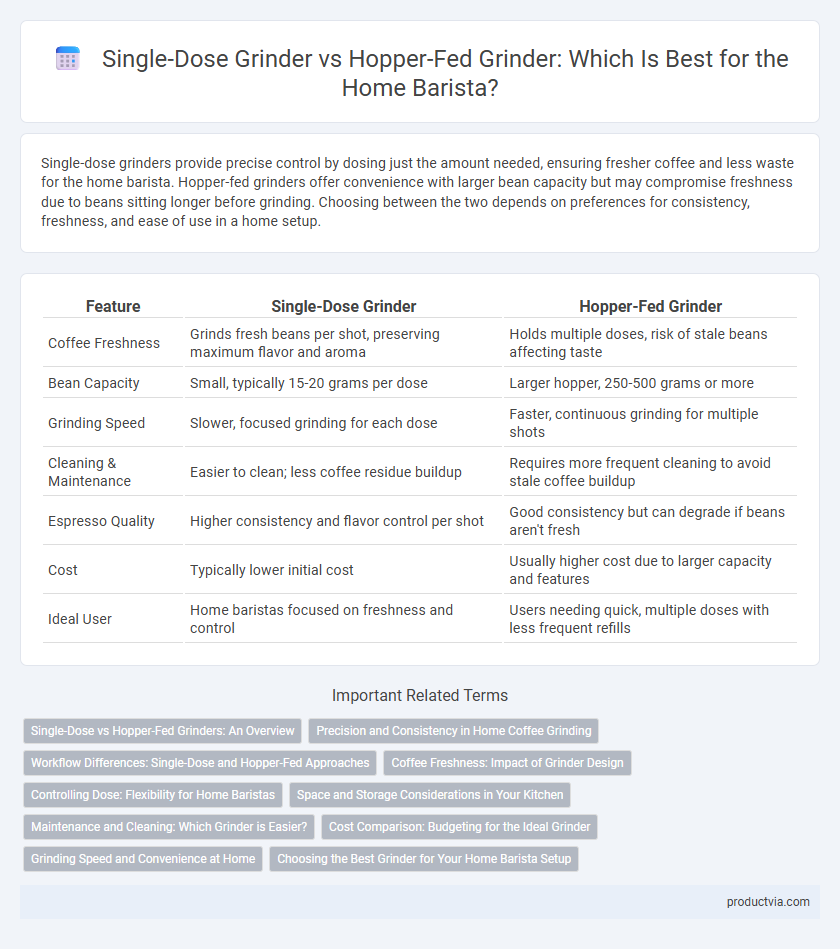Single-dose grinders provide precise control by dosing just the amount needed, ensuring fresher coffee and less waste for the home barista. Hopper-fed grinders offer convenience with larger bean capacity but may compromise freshness due to beans sitting longer before grinding. Choosing between the two depends on preferences for consistency, freshness, and ease of use in a home setup.
Table of Comparison
| Feature | Single-Dose Grinder | Hopper-Fed Grinder |
|---|---|---|
| Coffee Freshness | Grinds fresh beans per shot, preserving maximum flavor and aroma | Holds multiple doses, risk of stale beans affecting taste |
| Bean Capacity | Small, typically 15-20 grams per dose | Larger hopper, 250-500 grams or more |
| Grinding Speed | Slower, focused grinding for each dose | Faster, continuous grinding for multiple shots |
| Cleaning & Maintenance | Easier to clean; less coffee residue buildup | Requires more frequent cleaning to avoid stale coffee buildup |
| Espresso Quality | Higher consistency and flavor control per shot | Good consistency but can degrade if beans aren't fresh |
| Cost | Typically lower initial cost | Usually higher cost due to larger capacity and features |
| Ideal User | Home baristas focused on freshness and control | Users needing quick, multiple doses with less frequent refills |
Single-Dose vs Hopper-Fed Grinders: An Overview
Single-dose grinders offer precise control over coffee grounds by allowing baristas to grind exact amounts for each shot, minimizing waste and preserving bean freshness. Hopper-fed grinders, equipped with larger bean containers, provide convenience for frequent use but may expose beans to air longer, potentially reducing flavor quality over time. For home baristas prioritizing customization and freshness, single-dose grinders are often preferred, while hopper-fed models excel in speed and ease of use.
Precision and Consistency in Home Coffee Grinding
Single-dose grinders deliver exceptional precision by grinding only the exact amount needed, eliminating stale coffee and ensuring consistent flavor extraction for home baristas. Hopper-fed grinders offer convenience for larger volumes but can suffer from variable grind quality due to coffee bean exposure and dosing inconsistencies. Precision and consistency favor single-dose grinders, making them ideal for enthusiasts focused on achieving perfect espresso shots.
Workflow Differences: Single-Dose and Hopper-Fed Approaches
Single-dose grinders require precise measurement of coffee beans for each shot, enhancing control over freshness and consistency but adding steps to the workflow. Hopper-fed grinders hold a larger quantity of beans, enabling continuous grinding without interruptions, which streamlines the process but may sacrifice peak freshness. Home baristas must balance the meticulous preparation of single-dose grinding with the efficiency and convenience offered by hopper-fed systems.
Coffee Freshness: Impact of Grinder Design
Single-dose grinders preserve coffee freshness by allowing precise dosing and minimizing bean exposure to air, preventing oxidation and flavor degradation. Hopper-fed grinders risk staleness as beans remain stored for extended periods, increasing exposure to oxygen, moisture, and light. For home baristas prioritizing coffee freshness, single-dose grinders offer superior control over grind quality and flavor retention through minimized storage time.
Controlling Dose: Flexibility for Home Baristas
Single-dose grinders offer precise control over coffee dosing by allowing baristas to grind exact amounts for each shot, minimizing waste and ensuring freshness. Hopper-fed grinders provide convenience with continuous bean storage but may lead to variable dosing due to bean settling and clumping. Home baristas seeking flexibility and consistency often prefer single-dose grinders to customize grind size and dose for each brew.
Space and Storage Considerations in Your Kitchen
Single-dose grinders excel in space-saving design, ideal for home baristas with limited kitchen counter area due to their compact and streamlined build. Hopper-fed grinders generally require larger footprint and dedicated storage space for beans, making them less suitable where kitchen storage is constrained. Choosing a single-dose grinder supports efficient use of space while enabling fresh grinding for each brew without bulky bean hoppers occupying valuable room.
Maintenance and Cleaning: Which Grinder is Easier?
Single-dose grinders require more frequent but straightforward cleaning since they hold only one batch of beans, reducing stale coffee residue buildup and ensuring freshness. Hopper-fed grinders accumulate more coffee particles and oils in the hopper and burrs, demanding regular deep cleaning to prevent clogs and flavor contamination. For home baristas prioritizing ease of maintenance, single-dose grinders offer simpler and quicker cleaning routines compared to hopper-fed models.
Cost Comparison: Budgeting for the Ideal Grinder
Single-dose grinders typically cost between $150 and $400, making them a more affordable choice for home baristas focused on precision and freshness. Hopper-fed grinders range from $200 to $800, offering higher capacity but usually at a higher price point. Budget-conscious users should weigh upfront costs against features like grind consistency and dosing convenience to find the ideal grinder that meets their home brewing needs.
Grinding Speed and Convenience at Home
Single-dose grinders offer precise control over grinding speed, allowing home baristas to grind just enough coffee for each brew without waste, enhancing convenience during preparation. Hopper-fed grinders provide faster grinding speeds due to larger bean capacity, reducing the need for frequent refills but potentially sacrificing freshness between uses. For home use, single-dose grinders excel in maintaining bean quality and convenience with smaller batches, while hopper-fed grinders benefit those prioritizing speed and volume.
Choosing the Best Grinder for Your Home Barista Setup
Single-dose grinders offer precise control over coffee grounds and minimize stale bean residue, making them ideal for home baristas seeking freshness and consistency in each brew. Hopper-fed grinders provide convenience and capacity for multiple servings but may retain old grounds, affecting flavor purity. Choosing the best grinder depends on balancing the need for freshness with serving volume and ease of use in your home barista setup.
Single-dose grinder vs Hopper-fed grinder for home barista Infographic

 productvia.com
productvia.com